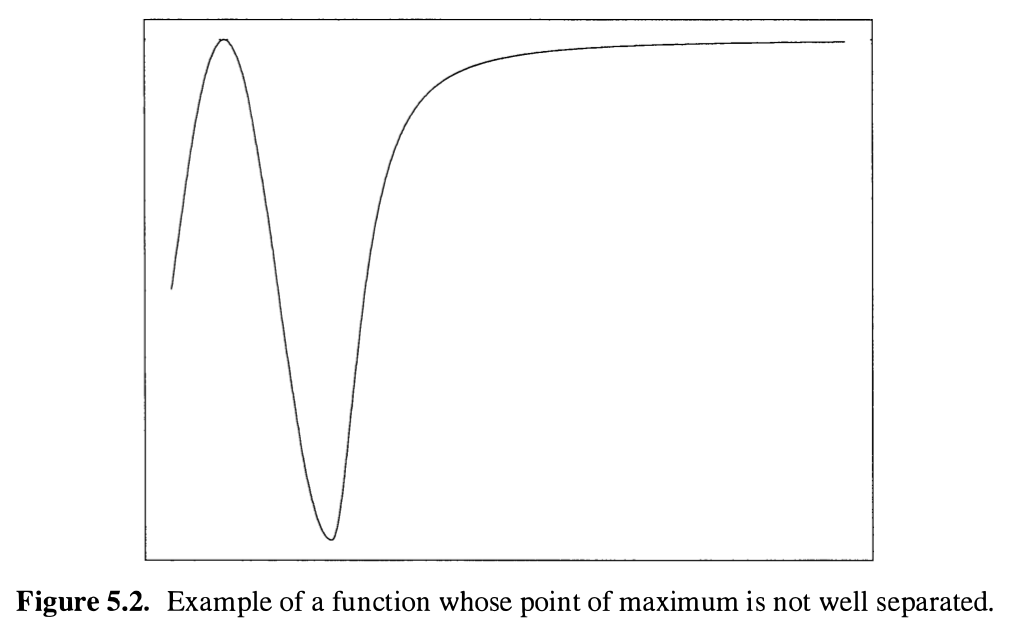M-estimator
Posted on (Update: )
Let $M_n$ be random functions and let $M$ be a fixed function of $\theta$ such that for every $\varepsilon > 0$
\[\begin{align*} \sup_{\theta\in\Theta} & \vert M_n(\theta) - M(\theta)\vert \pto 0\\ \sup_{\theta:d(\theta,\theta_0)\ge \varepsilon} &M(\theta) < M(\theta_0)\,. \end{align*}\]Then any sequence of estimators $\hat\theta_n$ with $M_n(\hat\theta_n)\ge M_n(\theta_0)-o_P(1)$ converges in probability to $\theta_0$.
The first condition says that the sequence $M_n$ converges to a nonrandom map $M:\Theta \rightarrow \bar\IR$, and the second condition requires that this map attains its maximum at a unique point $\theta_0$, and only parameters close to $\theta_0$ may yield a value of $M(\theta)$ close to the maximum value $M(\theta_0)$. Thus, $\theta_0$ should be a well-separated point of maximum of $M$, and a counterexample is the following figure,

Pay attention to the $o_P(1)$ in the inequality, bear in mind that it is a short for a sequence of random vectors that converges to zero in probability.
Let $\Psi_n$ be random vector-valued functions and let $\Psi$ be a fixed vector-valued functions of $\theta$ such that for every $\varepsilon > 0$
\[\begin{align*} \sup_{\theta\in\Theta} & \Vert \Psi_n(\theta) - \Psi(\theta)\Vert \pto 0\\ \inf_{\theta :d(\theta,\theta_0)\ge\varepsilon} & \Vert \Psi(\theta)\Vert > 0 = \Vert \Psi(\theta_0)\Vert\,. \end{align*}\]Then any sequence of estimators $\hat\theta_n$ such that $\Psi_n(\hat\theta_n)=o_P(1)$ converges in probability to $\theta_0$.
Let $X_1,\ldots,X_n$ be a sample from some distribution $P$, and let a random and a “true” criterion function be of the form:
\[\Psi_n(\theta) = \frac 1n\sum_{i=1}^n \psi_\theta(X_i)=\bbP_n\psi_\theta,\quad \Psi(\theta) = P\psi_\theta\,.\]Assume that the estimator $\hat\theta_0$ is a zero of $\Psi_n$ and converges in probability to a zero $\theta_0$ of $\Psi$. Because $\hat\theta_n\rightarrow\theta_0$, expand $\Psi_n(\hat\theta_n)$ in a Taylor series around $\theta_0$. Assume for simplicity that $\theta$ is one-dimensional, then
\[0 = \Psi_n(\hat\theta_n) = \Psi_n(\theta_0) + (\hat\theta_n-\theta_0)\dot\Psi_n(\theta_0) + \frac 12(\hat\theta_n-\theta_0)^2\ddot\Psi_n(\tilde \theta_n)\,,\]where $\tilde \theta_n$ is a point between $\hat\theta_n$ and $\theta_0$. This can be rewritten as
\[\sqrt n(\hat\theta_n-\theta_0) = \frac{-\sqrt n\Psi_n(\theta_0)}{\dot\Psi_n(\theta_0)+\frac 12(\hat\theta_n-\theta_0)\ddot\Psi_n(\tilde \theta_n)}\,.\] \[\sqrt{n}(\hat\theta_n-\theta_0) \rightarrow N\left(0, \frac{P\psi_{\theta_0}^2}{(P\dot\psi_{\theta_0})}\right)\] \[\sqrt{\hat\theta_n-\theta_0}\rightarrow N_k\left(0, (P\dot\psi_{\theta_0})^{-1}P\psi_{\theta_0}\psi_{\theta_0}^T(P\dot\psi_{\theta_0})^{-1}\right)\]here the invertibility of the matrix $P\dot\psi_{\theta_0}$ is a condition.
The function $\theta\mapsto \sign(x-\theta)$ is not Lipschitz, the Lipschitz condition is apparently still stronger than necessary.